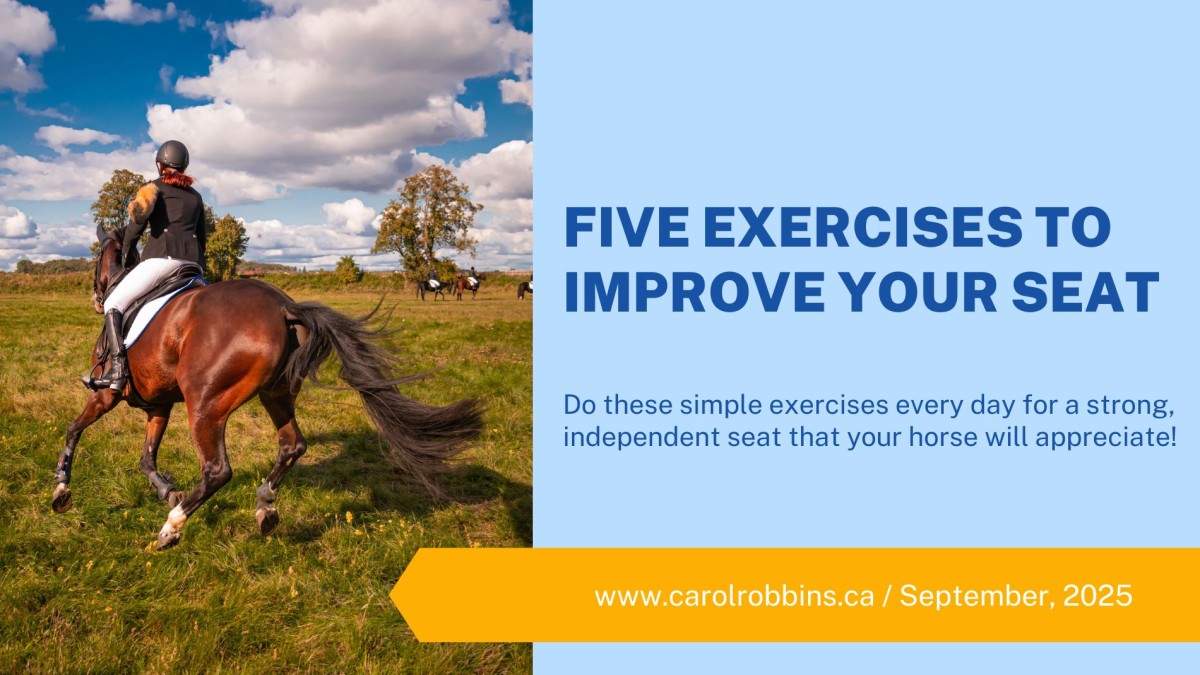Education is key when it comes to taking power over your own health and wellness.
I look at the role movement plays in your health and recovery to full and optimal function.
The articles on this site are not meant to take the place of medical advice and should not be used as such.
Five Exercises to Improve Your Seat

These five simple exercises can help develop an independent seat with a deep heel, flexible hip and following hands.
"Get your heels down! I said get those heels down....HEELS DOWN!"
How many times does your instructor repeat this in your lessons? How about "shoulders back, chest up?"
If your instructor is repeating phrases like these over and over through your sessions, it's not because you are stupid or a poor rider - it's because you are trying to jam body parts into positions that are not sustainable (and also possibly because your teacher is not very patient!).
Those positions are desirable not just for looks and correct equitation, but because they facilitate a balanced and independent seat, an ability to react swiftly, and a rider who is kind and empathetic to their horse.
The joint that facilitates a deep heel is the ankle, known anatomically as the talocrural joint. It involves three bones; the two lower leg bones (tibia, fibula) and a small dome topped bone at the apex of the foot called the talus, which sits on top of the heel bone (calcaneus). The ankle action where the heel is down is called dorsiflexion. The calf muscles have to be able to lengthen for this to occur, because they attach to the heel via the achilles tendon. If those muscles contract (shorten) they will pull the heel up, so it's imperative that you can use your leg on the horse without contracting the calf muscles to use your leg aids.
1. Calf Stretch
Now, you would think that stretching the calf muscles would put an end to this endless cycle once and for all. But although stretching pulls on the tendons and lengthens the muscles, it doesn't result in a permanent change (especially on the short term, and long term stretching might only affect the tendons which isn't ideal). So although our first exercise is called Calf Stretch, it's not about the sensation of stretch. Done well, it assesses the ability of the ankle to dorsiflex relative to the other structures around it.
To perform this exercise, you will need to be mindful and objective, so put aside your competitive nature for a moment and give it a try. (Click on the link to watch the video.)
2. Double Calf Stretch
This next exercise helps lengthen the glute (butt) muscles and the calf muscles too. I'm sure you can see how this will facilitate a long leg and a good hip hinge. This is helpful not only for jumping, but for those riding on the flat; a hip that is independent of the pelvis/lower back will allow a quieter seat and one where every leg position change doesn't affect the pelvis in the saddle.
3. Rhomboid Push-up
Soft following hands depend not only on the wrist, elbow and shoulder, but on the ability of the shoulder blades to move freely when necessary. The ability to protract (widen) the shoulder blades allows the arms to move independently of your spine and ribcage. The trunk thus remains solid and secure as the limbs respond to the need for applying necessary aids to the horse.
It seems counterintuitive to encourage the shoulder blades to move forward when your instructor is always telling you to pull them back, but the position of the spine and ribcage should be independent of the position of the shoulder girdle. Pulling your shoulder blades back does not equate good posture, in fact, if the blades are kept in a narrow position on the back, your only recourse to follow the horse's mouth is to straighten the elbows, which is not desirable. It's mobile shoulder blades that allows your arms to move!
This exercise allows you to practice a neutral spine on a horizontal plane (much like your horse!) which means the spine is not loaded vertically in gravity, and then moves the shoulder blades relative to the ribcage and spine.
4. Legs Up the Wall
This next exercise is pretty self explanatory. You might be astonished how much your inner thigh muscles feel this one! It's more about relaxing than stretching, so have some chairs or bolsters nearby. This lengthens and relaxes the muscles of the inner thigh, allowing for a long, relaxed "draping" leg.
5. Long Bridge with Dorsiflexion
Our last exercise is one that will help keep your legs back, emulates the foot in the stirrup with the pressure on the ball of the foot while the heel stays low (and you'll find it hard here too!). This strengthens the backs of the legs and hips and is one of my favourite exercises for everyone, but riders in particular! Work up to a 30 or 45 second isometric hold, and then try a single leg hold, working up to 30 seconds on each foot. You can also do a dynamic version where you come up and down, reaching through the heel as your hips extend.
I would love to hear from you if you try these! Do them daily for 4-6 weeks and let me know if they make a difference in your riding. You can also join my free community to discuss these exercises or anything else you may need help with.
I spent over 30 years riding hunter/jumper and dressage. I stopped riding around age 45 for lack of time and to focus on my human movement business!
Categories: : Riding

Subscribe to the weekly "Moves-letter!"
Get the newsletter delivered to your inbox with
course and workshop news, videos, articles, and subscriber-only offers!
I have read and agree to the terms & conditions.
 Carol Robbins
Carol Robbins 
